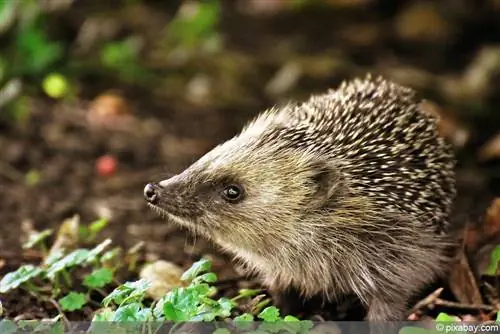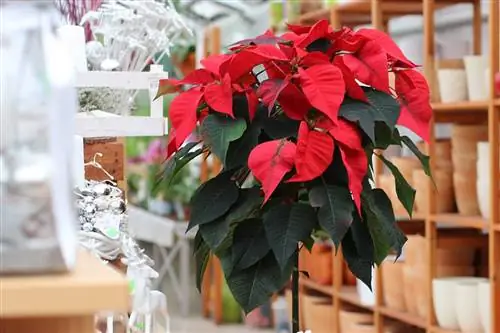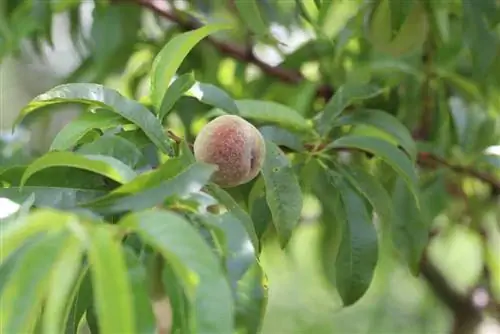- Author admin [email protected].
- Public 2023-12-17 03:39.
- Last modified 2025-06-01 06:48.
When the rose petals curl up in summer and autumn, this is usually due to the eggs of the rose leaf wasp, which are laid by the females on the underside of the leaves. To protect these and the later larvae, the insect pierces the leaves near the midrib so that they curl up. The rose leaf wasp itself is an inconspicuous pest measuring just four millimeters in size, dark and narrow, but with a large head. But the damage to the rose petals caused by eggs and larvae is clearly visible.
Causes
In the spring between April and June, the insects emerge from their pupae in the soil around the rose bushes. Then the female rose leaf wasps become active and lay their eggs on the rose petals. These are usually two to three eggs that are laid on the underside of the leaf. To ensure that the larvae can develop safely in the eggs, the wasp pierces the leaves on the midribs. This causes damage, which unfortunately cannot be overlooked:
- the puncture causes the leaves to curl up
- Larvae hatch and eat the first layer of leaves
- Even the leaves on which no larvae have hatched from the eggs laid no longer recover and remain curled up
Tip:
If you notice such damage to your rose bushes, you don't have to worry that the plants as a whole will be irreparably damaged, because this only applies to the affected leaves. That was harmful to the sight of the rose, but not to her life.
First measures
If the hobby gardener notices that the leaves on his roses are curling, action should be taken immediately. Although the affected roses are not damaged to such an extent that they would die from this infestation, but since the problem of an infestation by the rose leaf wasp will not solve itself, action should be taken immediately. If infected leaves remain on the rose bush, the larvae can continue to eat and develop. Before winter they fall onto the ground around the roses, remain there, burrow into the soil and pupate. In the spring, many new rose leaf wasps can hatch and infest the roses again. Therefore, you should always proceed as follows:
- from April or - earlier depending on the weather - observe the roses and react immediately
- cut off all affected leaves
- cut the affected areas directly on the stick
- always use sharp and disinfected scissors
- don't leave curled leaves on the rose
- Better to cut off one leaf too much than too little
- Put all of the waste in the household waste and dispose of it in this way
Tip:
Do not put the cut, infected leaves of the roses on the compost, because the larvae that were removed with the leaves continue to feed on the leaves and eventually fall off, crawl into the compost over the winter and then hatch in spring as new rose leaf roller wasps.
Prevention
If it is known that an infestation can already be seen in the neighborhood or on your own roses, then prevention is particularly helpful in order to prevent the rose leaf wasp from having the opportunity to hatch and multiply next year. The larvae drop from the leaves in autumn to crawl into the ground around the roses. There they pupate in order to hatch out again the next year as a finished wasp. There are preventive and suitable measures to prevent this from happening in the first place:
- Fertilize roses regularly, as a strong plant has more resistance
- so even if it was once infected, it can quickly form new leaves again
- adequate irrigation is also important here
- care must be taken to grow he althy and strong plants that can withstand any infestation by the rose leaf wasp
- If a rose was infected in spring/summer, action must be taken the following winter
- possibly remove the soil around the plants extensively
- do not dispose of the old soil in the garden
- spill the earth in the forest, for example, where the larvae no longer have a natural habitat
- apply new soil around the plants
- In this way, fallen and pupated larvae can be disposed of
- Apply lime to the new soil, this measure can be carried out several times a year
- absolutely avoid nitrogen fertilization
Tip:
If you choose rose varieties for your garden that have smooth, shiny and curled leaves, you are less likely to have to deal with an infestation of rose leaf roller wasps. Because these types of roses are attacked less frequently.
Use natural enemies

Like every pest, the rose leaf wasp also has natural predators, which can be established in your own garden with a little help and thus protect the roses in a natural way. This includes all types of native bird species, primarily the blue tit, as well as caterpillar flies, spiders, parasitic wasps, ground and soft beetles, shrews and hedgehogs. The best way for these animals to settle in the garden is to make it as natural as possible so that the predators feel comfortable and don't migrate again:
- Pile up leaf waste in a corner as shelter for small animals and hedgehogs and leave it lying there
- Provide insect hotels for the parasitic wasps near the roses
- Hedgehogs, mice and the like also feel comfortable in corners with stacked branches
- small stone walls beautifully arranged in the garden serve as a shelter for many insects and little residents
- Stop feeding birds from the warmer days in spring
- otherwise they won't go fishing for insects
- Avoid insecticides and pesticides in natural gardens
- This may affect the natural enemies rather than the rose leaf wasps themselves
Combat using pesticides
Of course, the use of pesticides is also possible. Unfortunately, this is not very close to nature and should only be carried out if the pest infestation is severe. When spraying the leaves, they usually don't even reach the larvae that are curled up and well protected and they still survive. However, if you don't want to forego the use of pesticides, you should proceed as follows:
- spray the soil around the roses in late winter
- In this way, larvae that are already in the soil can be destroyed
- spray the undersides of the leaves in spring before they have curled up
- so any eggs that have just been laid can be destroyed
- Combat adult rose leaf roller wasps in spring with appropriate commercial pesticides
- Get advice from a specialist retailer about which products are approved and can be used
Tip:
However, since the use of pesticides is usually not very promising, this can actually be avoided, also in view of nature and the damage caused by spraying poison.
Conclusion
If you cultivate a lot of roses in your garden, you should create a garden close to nature and thus confront possible pests, such as the rose leaf roller wasp, with natural predators. Because this is still the most sensible measure against these annoying pests that destroy the beautiful appearance of the roses. But preventative measures and gentle means of combating it also help to ensure that the roses look beautiful again at least next year. Because even if the rose leaf wasp damages the leaves of the roses, the rose stem remains largely unaffected and in the next season the attractive roses will bloom again in all their colors after good care.






